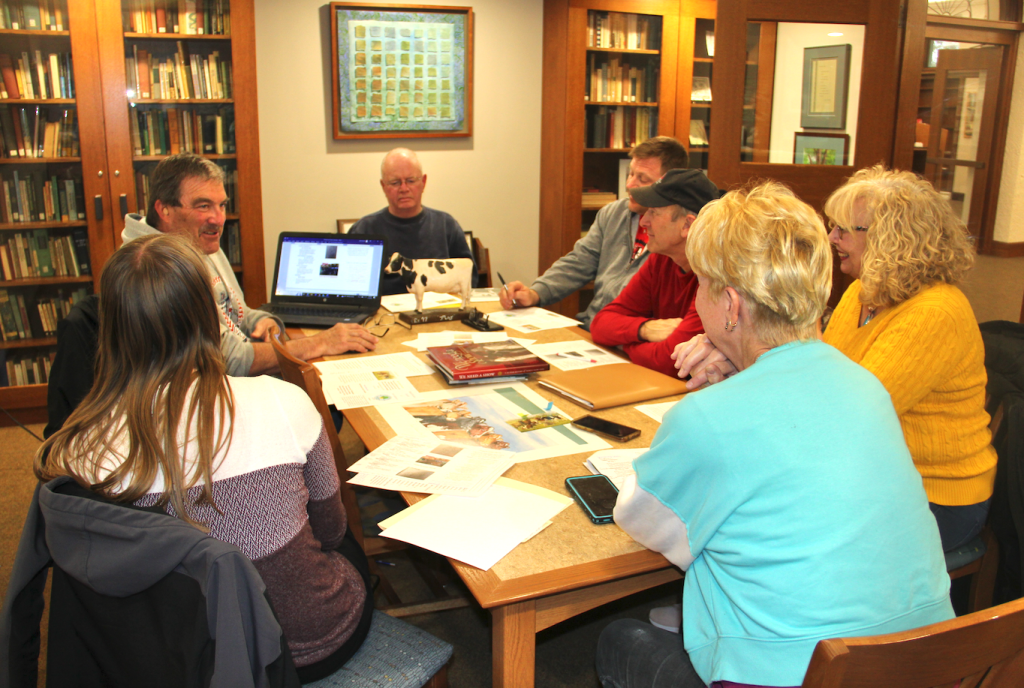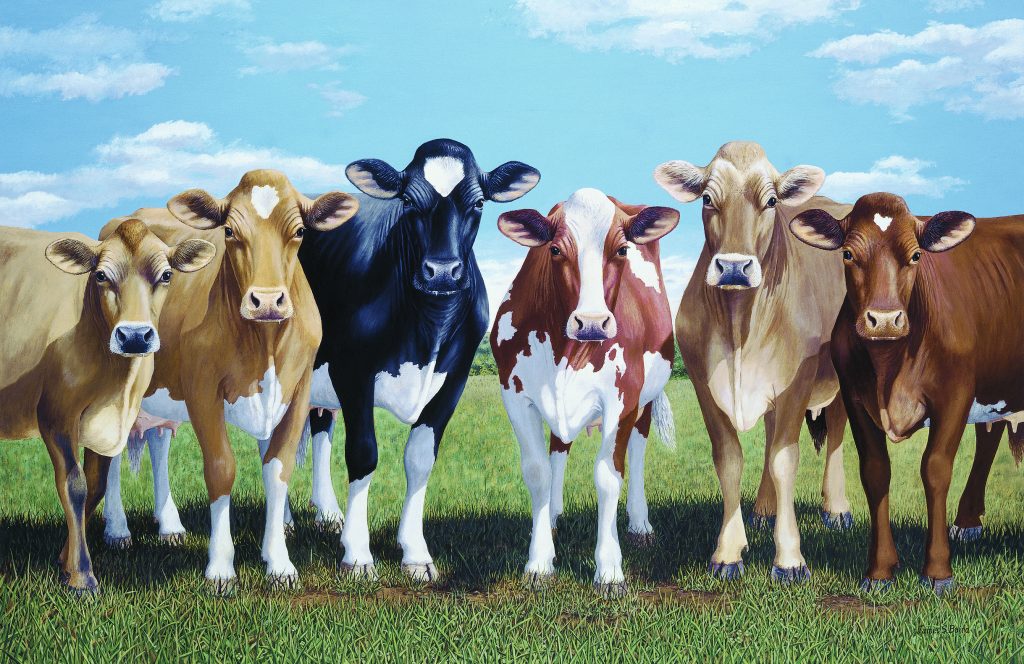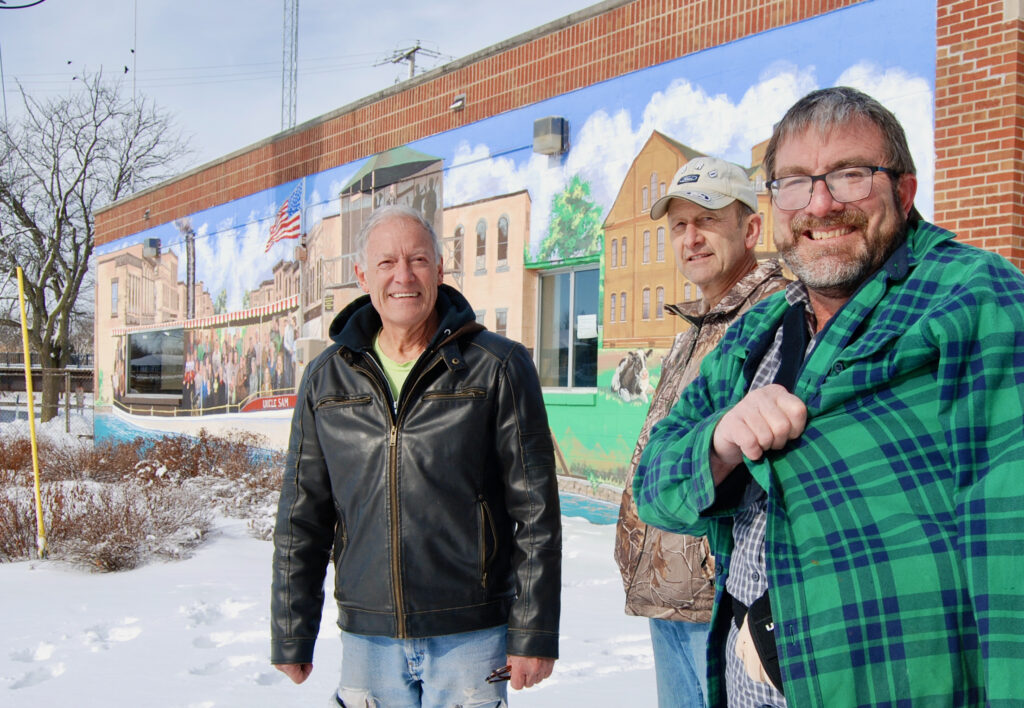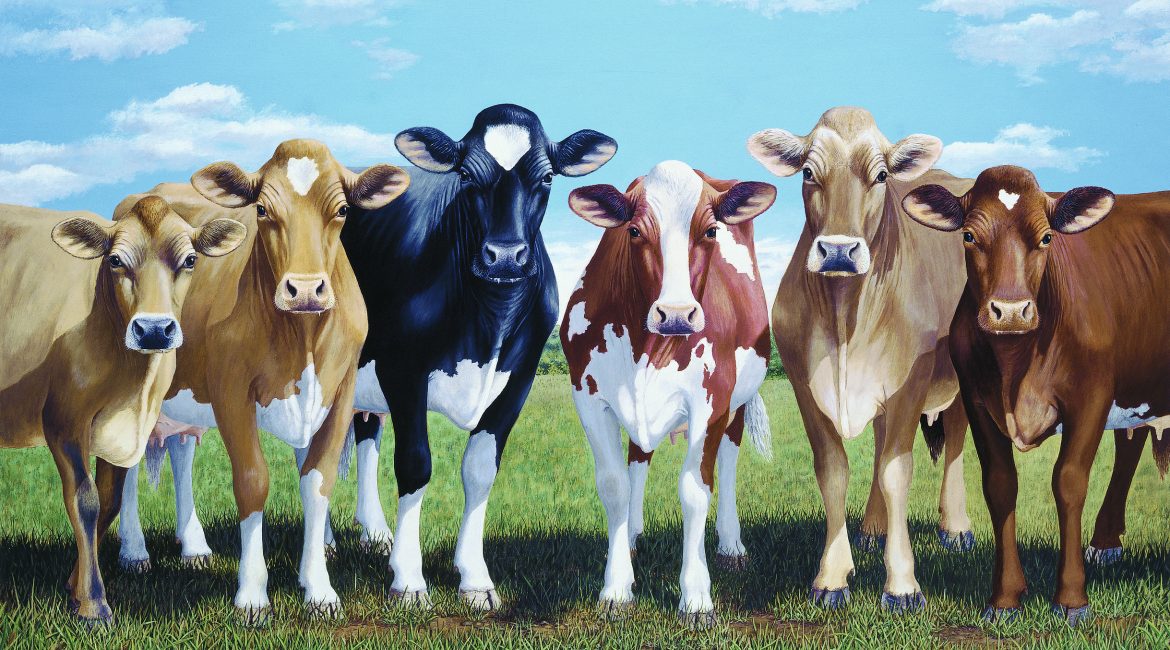By Chris Spangler
The Fort Atkinson Beautification Council is moo-ving forward with a project designed to showcase the community’s rich dairy history.
The council has announced a “parade of cows” that will place near-life-size statues of the seven major dairy breeds throughout the city’s main thoroughfares.
Those breeds are: Holstein, Red-and-White Holstein, Guernsey, Jersey, Brown Swiss, Ayrshire and Milking Shorthorn.
“Being the home of the National Dairy Shrine, Hoard’s Dairyman and (the late) William Dempster Hoard, it is very important that we become more of a tourist destination for cows,” according to the committee in charge of the project, which includes Jude Hartwick, Alan Cook, Gail Cook, Ryan Ebert, Mariah Hadler, Trish Jonas, Peggy Brandenburg, Roy Hetts, Deb Lundy and Katelyn Allen with Tourism Committee input from Holly Tierney.
“Not only is Wisconsin America’s Dairyland, but also Fort Atkinson has been home to many dairying businesses, inventions and initiatives.”
The members noted that they hope to not only honor Fort Atkinson’s dairy legacy, but also attract tourists to the community.
“The seven statues will be positioned throughout the major arteries of Fort Atkinson. The intent of each replica is to be visible, yet to not obstruct traffic views,” they said.
Each statue will have a QR code linking it to the Hoard Historical Museum, Dairy Shrine and sponsor’s webpages so viewers can learn about the breed and local history.
“The ‘cow parade’ will attract visitors to Fort Atkinson year-round, not just during World Dairy Expo or W.D. Hoard Day. Hopefully, businesses will creatively enhance the cow parade with a rectangular butter churn in front of the antique stores, a giant cheesehead/block at Verlo’s Creamery Building or McDonald’s, milk or ice cream drinks at the local taverns, etc.,” the panel said in its proposal.
“This could be Fort Atkinson’s chance to develop a theme beyond General Atkinson’s fort, but a ‘Fort herd ’round Wisconsin,’ indeed, the United States.”
The committee stated that, like the giant catfish next to The Bridge, the cows’ quirky and unique attributes could draw visitors to town, as well as add more reasons for them to stay after visiting The Fireside Theatre, museum, area bicycle trails or other local attractions.
“Like New Glarus, we will become fashionably quirky. The city businesses will hopefully get behind the theme and tourists will come to see what the fuss is about,” the panel added.
What and where?
Each cow will weigh approximately 125 pounds and measure 4 feet, 9 inches in height and 7 feet, 4 inches long from its nose to tail, making it about three-quarters of the size of a live cow. It will have a 7-foot girth.
All fiberglass construction, it will have a hollow body with gently rounded edges and permanent mounting points for installation on concrete pads.
Larry Schultz of Sunny Beach Farm Studio, the Milton artist who created the downtown community mural overlooking the north bank of the Rock River, will paint the statues.
The committee noted that the Holstein statue will be located on a terrace near Subway along Madison Avenue. It is on the Hetts family’s former Crescent Beauty Farm, near where Gene Acres Felicia May Fury is buried. Felicia May was named Supreme Champion of all breeds at the 1974 World Dairy Expo and Holstein Cow of the Millennium at the Wisconsin Holstein Convention in 2000.
In fact, this cow replica will be painted to resemble Felicia May’s markings.
The Brown Swiss will be located in front of the Fort Atkinson Area Chamber of Commerce, at the corner of North Main Street and Madison Area.
The Guernsey will be placed in the garden spot fronting W.D. Hoard & Sons’ parking lot at the corner of South Main Street and West Milwaukee Avenue.
The downtown locations for the Jersey, Ayrshire, Milking Shorthorn and Red-and-White Holstein are to be determined, pending approval by the city and property owners.
Project cost
The overall project cost is not expected to exceed $35,000.
FAST Fiberglass LLC of Sparta is charging $4,000 per cow statue, $1,000 off the usual pricetag due to the large number purchased. Alan Cook has volunteered to pick them up with his cow carrier and Schultz has agreed to paint them for the same price that FAST would charge: $400 to $500 per statue. Thus, each cow is costing about $5,500.
Major sponsors thus far include Brian Knox, president of W.D. Hoard & Sons Co.; Crescent Beauty Farms/the Hefts family; and the Fort Atkinson Area Chamber of Commerce.
The committee stated that it also is seeking some grant funding, and the National Dairy Shrine has indicated it also will help finance the project.
“Sponsorships of individual statues will be attempted, not only for purchasing the replica, but also for yearly upkeep and maintenance,” the panel said.
A list of donors will be recorded and available at the Hoard Museum/Dairy Shrine.
Public fundraising is underway, with donor designations being: Supreme Champion, $4,000-plus; Grand Champion, $2,500 to $3999; Intermediate Champion, $1,000 to $2,499; Junior Champion, $500 to $999; Rosette, $250 to $499; and Blue Ribbon, $25 to $249.
Special gifts will be given to donors in each sponsorship level.
Persons may give tax-deductible gifts to the nonprofit organization’s “cow parade” project on its website, www.Fortbeauty.org, or by sending a contribution to the Fort Atkinson Beautification Council, P.O. Box 152, Fort Atkinson, WI, 53538.
The organizers said they hope to dedicate the “cow parade” on either W.D. Hoard Day, Oct 14, 2023, or during World Dairy Expo Oct. 1-6, 2023.
“Quirky, fun, historical, educational and just plain interesting would be all adjectives to describe this project,” the committee stated. “Fort Atkinson could promote itself more on its dairy history/heritage, thus becoming a destination spot for those interested in dairying. From our cheesehead-wearing Packer fans around the world (to these cow statues), we have potential to tap into a tourist bonanza.”
The seven breeds
The committee members noted that all seven breeds have their own strengths and weaknesses depending on climate, altitude, purpose and uses of their milk.
Holsteins are easily the most common dairy breed in the world, found in 150 countries. They produce on average the most milk per cow of the breeds. The Holstein Friesian Association of America was founded in Brattleboro, Vt., in 1885.
By 1857, American dairy farmers began to import Holsteins from Holland. Red-and-White Holsteins are genetically the same as their black-and-white counterparts with the exception of having two recessive genes for coat color.
Jersey cattle were imported from the Channel Island of Jersey and Brown Swiss originated in the Swiss Alps. Milking Shorthorn cattle came from England, while Ayrshire is a Scottish breed of dairy cattle.
Guernsey cattle came from the English Channel Isle of Guernsey. In 1877, the American Guernsey Cattle Club was founded in Peterborough, N.H.
W.D. Hoard and his grandson, W.D. “Bill” Hoard Jr., were great promoters of the Guernsey breed.
Guernsey milk has a golden color due to a pigment, beta carotene. The body converts beta carotene into Vitamin A (retinol), which is important for vision and keeping vital organs like heart, lungs and kidneys healthy.
Guernsey milk also has a higher percentage of butterfat and protein than Holstein milk.
Jerseys also have high components and have been growing in favor for a long time. They are smaller and more refined, but are much more heat-tolerant than Holsteins and have better reproductive performance.
Brown Swiss cattle are the best choice for mountainous countries such as their native Switzerland.
Dairying history
As the Beautification Council members noted, Fort Atkinson wrote a prominent chapter in Wisconsin becoming “America’s Dairyland.”
It not only is home to the National Dairy Shrine at the Hoard Historical Museum, but also to agricultural companies such as W.D. Hoard & Sons Co., Nasco, Jones Dairy Farm and J-Star/Digi-Star.
It was William Dempster Hoard who pioneered dairying in the Midwest. Born Oct. 10, 1836, in New York State, he was employed on a dairy farm before moving in 1857 to Wisconsin, where he worked on a Dodge County dairy farm.
He volunteered for the Union Army in 1861, serving with the 4th Wisconsin Infantry and 1st New York Artillery until the end of the Civil War.
Hoard founded the Jefferson County Union as a weekly newspaper on March 17, 1870, in Lake Mills. Fort Atkinson businessmen convinced him to move to their community in 1873.
At that time, one-crop farming — that of wheat — was the most popular type of agriculture in Wisconsin. Familiar with dairying from his native New York and always a lover of dairy cattle, Hoard devoted many columns of his early-day newspaper to dairy farming.
On the strength of the popularity of those dairy columns in the Jefferson County Union, Hoard founded Hoard’s Dairyman as a separate publication in 1885. It was through the pages of that popular magazine that he was able to have such a vast influence on farming methods in every state of the nation and in every foreign country where dairy farmers are found.
This so-called “bible of the dairy industry” spread useful information to dairy farmers nationwide and still is one of the most popular dairy periodicals in circulation today.
Hoard also pioneered a “scientific approach to dairy farming” that was revolutionary in that time. He helped found the Wisconsin Dairyman’s Association in 1872 and was instrumental in creating the Wisconsin State Dairy Board in 1874.
Serving as Wisconsin governor from 1889-91, Hoard created the nation’s first Dairy and Food Commission, fought for stricter standards for food safety and opposed legalizing dairy substitutes for food.
In addition, he is credited with introducing alfalfa in Wisconsin. Hoard recognized early the value of the tuberculin test for cattle, promoted the silo as a solution for dairy farmers’ feeding problems, worked to initiate the state soil survey and was a leader in cow testing association activities.
Hoard served as a member and as president of the University of Wisconsin Board of Regents, and partly through his efforts, the university’s famed College of Agriculture was founded. His statue stands to this day in front of Agriculture Hall on campus.
In 1915, he was honored as “Wisconsin’s Most Distinguished Citizen” at the World’s Fair in San Francisco. He passed away three years later.
For his role as a publisher, Hoard was inducted into the Wisconsin Newspaper Association Hall of Fame in 2005.
In 2010, the Wisconsin Legislature enacted a bill designating Oct. 10 as W.D. Hoard Day. It coincided with the 125th anniversary of the magazine.
Other dairy pioneers
Hoard certainly is not the only agricultural pioneer with deep Fort Atkinson roots.
In 1832, government surveyor Milo Jones moved from Vermont to what is now Fort Atkinson with his wife, Sally Crane Jones, and their two children to establish a traditional dairy farm. They made cheese and butter, as well as raised pigs for their own consumption.
Their son, Milo C. Jones founded Jones Dairy Farm as the manufacturer of “little pig sausages” in 1889.
In 1912, W.D. James founded the James Manufacturing Company in Fort Atkinson. He earlier had invented the first adjustable cow stanchion in a blacksmith shop, and as very small herds of cows grew larger, James’ forged steel barn cleaners, drinking cups, stanchions, bulk tanks and silo unloaders helped dairy farmers nationwide become more efficient and give their families a higher quality of life.
In 1922, James built a state-of-the-art dairy barn on 80 acres he had purchased from the Jones family. Four men worked on the farm, which delivered fresh Guernsey milk — “Kleen Milk,” as it was called — and eggs to area homes. The Jones family bought back the barn and land after the W.D. James’ death.
The Creamery Package Company was founded in 1920, manufacturing equipment for creameries, cheese factories, dairies and ice-cream plants.
Nasco opened in Fort Atkinson in 1941. By the 1960s, its Farm and Home Store was a place where dairy producers could fill their needs for just about any item imaginable. Its catalog business exploded.
Arthur Nesbitt came to Nasco from the Pennsylvania Holstein Association, serving as Nasco’s CEO for decades. He became a dairy industry leader and helped World Dairy Expo grow and prosper in its first 50 years.
Prominent dairy farms
Fort Atkinson also has been home to numerous prominent dairy farms.
Crescent Beauty Farm was located on the northwest edge of Fort Atkinson, along U.S. Highway 12 where the high school, hotels and other commercial properties are located today.
In 1949 at the age of 28, Allen Hetts showed Crescent Beauty Lady Gloria, a 3-year-old Holstein, at the National Dairy Cattle Congress in Waterloo, Iowa. She was named Grand Champion Female.
He repeated this feat nine years later with another aged cow.
Hetts was one of the founders of World Dairy Expo in Madison. He was recognized by his peers for being one of the best showmen and fitters in the country when he won the Klussendorf Trophy in 1970.
These skills reportedly were the reason Ray Potter sold him Gene Acres Felicia May Fury as a 3-year-old cow. The award-winning bovine had 40 offspring before dying at age 18.
By the 1950s and 1960s, there were dozens of small dairy herds consisting of all seven breeds with Fort Atkinson addresses. Health-Way Dairy in Fort Atkinson provided milk from local dairy producers to the school district. Students could buy a six-ounce bottle of white or chocolate milk for two cents.
Other dairy producers
Perhaps one of the finest Holsteins born in Fort Atkinson was Future Hope Reflector Blacky, owned by Harold and Lucille Draeger.
They had seven children: Donna, Roger, Ralph, Marilyn, Peter, Pam and Andrea. Roger showed Blacky. Marilyn served Wisconsin as Alice in Dairyland in 1963. Pete took over the dairy farm in 1972.
Blacky came from a strong maternal line and her pedigree included two of the greatest bulls of all time: Wisconsin Admiral Burke Lad and Johanna Rag Apple Pabst. In July 1965, Blacky and her stable mate, Future Hope Faith Esther, were named Grand Champion and Reserve Grand Champion at the Wisconsin Championship Show held in Rice Lake. Blacky also won the four-year-old class at the National Dairy Cattle Congress in Waterloo, Iowa.
Tara Hills Farm of New York and Brigeen Farm of Maine purchased Blacky and her daughter, Future Hope Rocket Flicka, from the Draegers. Flicka later classified Excellent 97 points (the highest score possible). Blacky later sold for a world record $125,000 at the 1974 Shore Canadian Classic Sale.
Blacky’s legacy is that her genetic contributions improved many herds throughout North America.
The herd of Guernsey cows at Jones Dairy Farm was converted to Holsteins in 1974, with stalls reconstructed for larger cows. The Holsteins did well and in 1980, a Jones home-bred consignment to the Kentucky Bluegrass Classic Sale, J-D-F Ivy Una, topped the sale with the bid of $6,100.
Local dairy leaders
The list of national dairy leaders who resided in or around Fort Atkinson is remarkable, the Beautification Council panel noted. The big three at Hoard’s Dairyman were the late publisher William D. Knox, late managing editor Eugene Meyer and late art director James Baird.
Craig Beane was a founder of National Dairy Herd Improvement Association and also a longtime contributor to the Wisconsin Agriculturist magazine, fielding questions on dairy herd management, expanding dairy facilities and milk marketing. He and son Tom Beane’s Hol-Wis Farms co-hosted the 1956 Farm Progress Days with William and Ted Ward’s Wardland Farm.
Bill Maynard was executive secretary of the American Guernsey Cattle Club before moving his family to Fort Atkinson to become a part of the Hoard’s Dairyman team. Leslie Peckham was the longtime national field man for the American Guernsey Cattle Club.
John Meyer learned business from Nesbitt at Nasco before becoming executive secretary of the National Brown Swiss Association. In 2002, he was hired as CEO of Holstein Association USA Inc., a post in which he remains today.
Considering all of the local people and businesses that have contributed to improving dairying in America, it is only fitting that the seven breeds of cows be featured in Fort Atkinson, the Beautification Council concluded.
“A parade of seven beautiful cows through the streets of Fort Atkinson would celebrate a legacy of historic excellence,” it said. “It would be meaningful and appropriate. There is no city with Fort Atkinson’s dairy heritage anywhere else in the world.”

Members of the Fort Atkinson Beautification Committee work on a tri-fold brochure to assist with fundraising for seven statues of the seven dairy breeds planned to be placed along the city’s main thoroughfares. The “cow parade” is designed to honor the community’s rich dairying history, as well as draw tourism. Members, some of whom are pictured above and not in listed order, include: Jude Hartwick, Alan Cook, Gail Cook, Ryan Ebert, Mariah Hadler, Trish Jonas, Peggy Brandenburg, Roy Hetts, Deb Lundy and Katelyn Allen, with Tourism Committee input from Holly Tierney. Chris Spangler photo.

Six of the seven bovine dairy breeds are featured in a painting by the late James R. Baird of Fort Atkinson. Baird served as art director for Hoard’s Dairyman magazine for 44 years. He retired in 1993 and passed away in 2016. The painting shows only six of the seven recognized breeds in America because Red-and-White Holsteins were not very prevalent back when Baird created the painting, titled “Foster Mothers of the Human Race.” Pictured are Jersey, from left, Guernsey, Holstein, Ayrshire, Brown Swiss and Milking Shorthorn. Contributed by Hoard’s Dairyman.

Milton resident and award-winning artist Larry Schultz, at right, in 2022, visits the mural he painted on the Fort Atkinson Water Department Building, which he completed in 2021. He was greeted by Fort Atkinson Beautification Council members Vice President Alan Cook, center, and President Jude Hartwick. The Fort Atkinson Beautification Council commissioned Schultz to paint the mural on the city’s water building and will soon be commissioning the artist to paint several nearly life-sized cows as part of a new project titled: “Parade of Cows.” File Photo/Kim McDarison. An earlier story about Schultz and his artwork, including magazine covers painted for the “Hoard’s Dairyman” magazine in 2016 and 2020, is here: https://fortatkinsononline.com/water-building-mural-artist-to-present-workshop-sunday/ File photo/Kim McDarison.
This post has already been read 5829 times!
